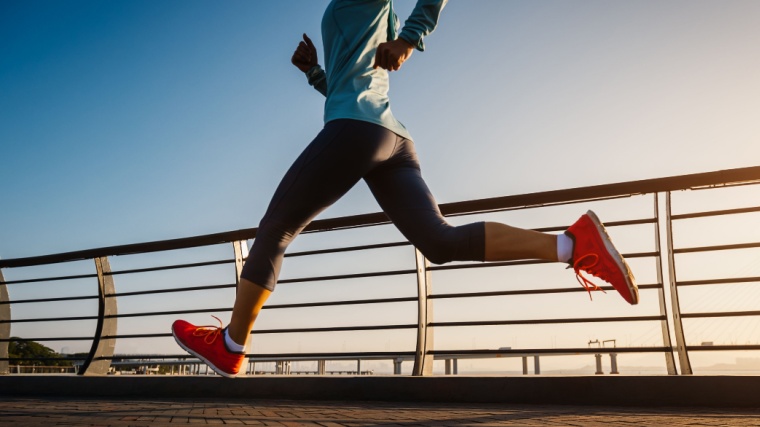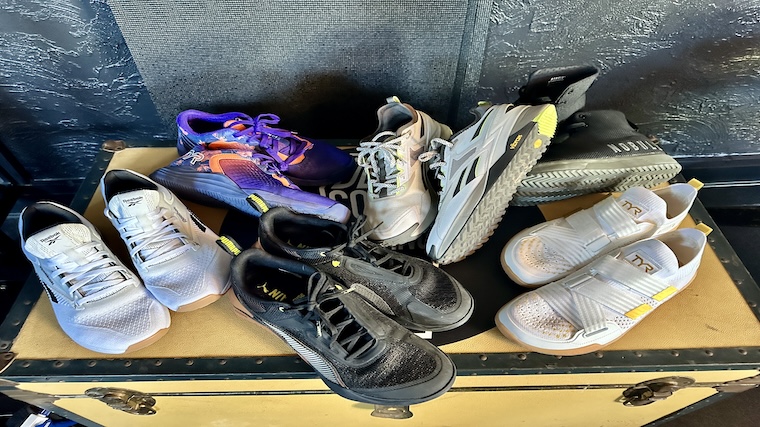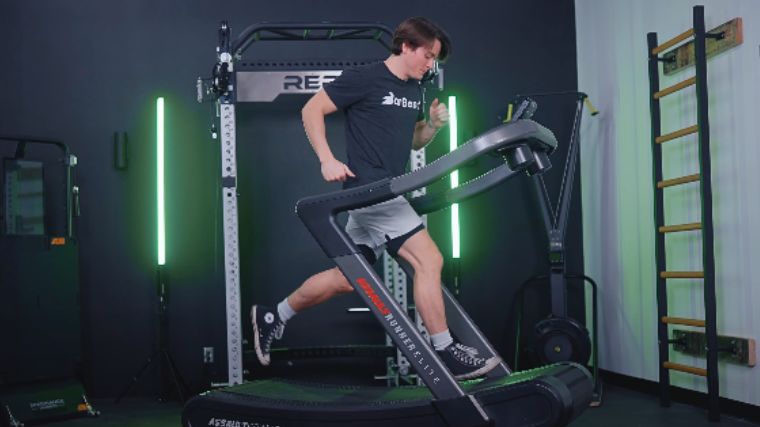The good news about your brand-new running shoes is that they’re sleek, cushioned just right, and — if you do say so yourself — just a little bit sexy. The bad news is, the newer the shoe, the tougher it can be on your feet for the first run or two.

Figuring out how to break in running shoes (the right way) can be a journey. We’re here to shorten that journey for you. I sat down with elite running coach Lee Whitaker to help you break in those new kicks properly (and find a new pair if you’re in the market).
What Are Running Shoes?
Running shoes are shoes that have been specifically engineered to cater to the needs of runners and improve running performance. (1) Most pairs of running shoes are flexible so as not to impede your natural joint functions. They also have added cushioning in the areas where your foot strike is likely to occur so that you are protected from repeated impact with the ground.
As a world-class ultra-distance runner, Whitaker is the right guy to talk to about breaking in a brand-new pair of shoes, since he burns through them so frequently.
If you went for a run in a standard pair of walking shoes, it’s probably going to make the bottom of your foot hurt.
— Lee Whitaker
“The design of the shoe, the foam, and the cushioning of a walking shoe is much different from a running shoe,” Whitaker continues. “You wouldn’t get the same type of rebound, and your toe wouldn’t feel the same inside of it. The best way I can put it is your feet would probably feel flat and sluggish, like running on cement as opposed to a trampoline…There’s a bounce you’re expecting from a running shoe that another shoe won’t give you.”
Tips for Breaking in Running Shoes
You might think you already know how to break in running shoes, but the blisters on your feet say otherwise. Even if your running shoes technically fit your feet when you wear them inside the store, they won’t necessarily feel good when you’re actually out running in them.
[Read More: Expert Tested: The Best Treadmills for Running]
Here are two simple tips for what you should pay attention to as you’re navigating your shoes’ break-in period.
Give it Some Time
Even if your old shoes are no longer doing their job properly, they probably still feel comfortable to wear. This is because they’ve been given ample time to adjust to the unique contours of your feet. If you buy new running shoes fresh off the rack, they haven’t been given any time to be customized through routine wear. It will likely happen eventually; you simply need to be patient.
Just don’t give up on the shoe after one or two wears. If you’re chafing or getting sore or blisters, you might simply need socks that better accommodate this pair. Or, you may just need more time for your shoes to get acquainted with the nuances of your feet.

[Read More: The Best Cross-Training Shoes (Personally Tested)]
“Certain shoes are more stiff, less stiff, or have thicker soles or thinner soles,” says Whitaker. “There are a lot of variables. Generally speaking, in a week or two of running in a shoe, by then you’ll have a pretty good feel for if the shoe is going to work. You should have gotten the shoe to a pretty decent place in terms of its flexibility and suitability for training. I think a week or two is probably all you need.”
Wear Them Frequently
Even a perfect pair of running shoes probably won’t feel like a natural extension of your feet during your first run in them. You will probably have to begin with a few short runs to let them slowly grow accustomed to your feet. Going on shorter runs than normal also spares your feet from enduring any additional pain before you graduate to longer distances.
“You can start by just wearing them around the house or wearing them out to the grocery store or something like that — just put them on and walk in them and wear them a little bit,” advises Whitaker. “Take them out for a one-to-three-mile run. Just a short run where even if they’re uncomfortable, it’s probably not going to cause any damage.”
Benefits of Running Shoes
Before you decide to pay a visit to your local running store and take a trial run in a new pair of sneakers, here are the characteristics you should be looking for in your new shoes:
- Light Weight — Your shoes should contribute to the fleetness of your feet without weighing you down.
- Flexibility — An ideal running shoe will move as if it’s an extension of your foot, enabling natural movement without locking your feet into place.
- Cushioning — Running shoes provide cushioning in the areas where your feet strike against the ground, potentially reducing your odds of developing an injury from repeated impact.
- Assisted Rebound — Running shoes should provide your feet with a bit of a bounce, making it easy for you to spring into the next stride.
- Comfort — The toe box of a running shoe shouldn’t compress your toes, and many offer diverse widths to help you retain comfort over long distances.
How to Choose the Best Running Shoes for You
With so many running shoes to choose from, you have far more factors to consider beyond simply whether or not the running shoes fit. To select the shoe model that will give you the ultimate running experience, here are some tips provided by one of the best running coaches around.
Trust Your Experience
If you have experience with running and you’ve already gone through a few pairs of shoes, you probably have a good sense of what type of shoe works best for you, including the brand your feet and your wallet like best. At a minimum, you probably have enough experience to select the right pair of shoes based on your experience with your previous pair of shoes.
[Read More: What Are Cross-Training Shoes? How to Pick the Best Pair of Cross-Trainers for You]
“At this point, I’ve had enough shoes and understand my gait enough to kind of know which types of shoes work well for me,” says Whitaker. “From a brand perspective, all the high-end brands that you know like Nike, or Asics, or Saucony, or Hoka, they are all shoes that are of generally good quality and that perform well.”
Get a Gait Analysis
It would be highly convenient if shoe size was the only characteristic of a running shoe that you need to be concerned with. But this is not the case, as different pairs of shoes can be built for very different running styles. To ensure that your brand-new pair of New Balance sneakers is actually the best pair of running shoes for you, a gait analysis would be a wise use of your time.

[Read More: The Best Shoes for Treadmill Running, Ran In and Tested by Our Experts]
“I always tell people that are getting into the sport or maybe don’t have the experience to visit a reputable running store where they do gait analysis and they can line you up with the proper shoes for your gait,” says Whitaker. “Everyone has a little bit of a different gait, and shoes are made differently. You don’t want to have a certain type of gait and then you get a shoe that’s designed for someone with the opposite type of gait.”
Find Out if You Need a Specialty Fit
The shape of your feet may vary sharply from that of other runners. This is fine; we’re all different. Still, getting ordinary running shoes for your distinct foot shape might result in soreness that doesn’t go away, and no break-in process can overcome it. In these instances, the right pair of shoes for you might be highly specialized, and require you to be more selective.
[Read More: The Best Stability Running Shoes, Tested and Trialed by Our Team]
“Aside from shoes intended for a specific gait, there are also stability shoes, and shoes for flat and high arches, and for all different shapes of feet,” points out Whitaker. “So seeing if you need a specialty fit is going to be extremely helpful because if you have super high arches, it will do you no good to get a shoe for someone with low arches. There are also shoes for people who have overpronation in their feet. You need a shoe that aligns with your personal foot size and foot shape.”
Frequently Asked Questions
Still have questions about that new pair of kicks? Here are the answers you’re searching for.
How do you break in running shoes fast?
The fastest way to break in running shoes is to wear them frequently — including when you’re not running — and to wear them for short runs to break them in gradually, in a way that won’t hurt your feet.
How long does it take to break in running shoes?
If you wear running shoes regularly to break them in, it typically takes a couple of weeks to adequately break in a new pair of running shoes.
Is it normal for feet to hurt with new running shoes?
It is normal for feet to hurt when trying out new running shoes. However, excessive chafing, soreness, and blisters are probably signs that your new shoes are not a proper fit, or you are attempting to break them in too aggressively.
References
- Black MI, Kranen SH, Kadach S, Vanhatalo A, Winn B, Farina EM, Kirby BS, Jones AM. Highly Cushioned Shoes Improve Running Performance in Both the Absence and Presence of Muscle Damage. Med Sci Sports Exerc. 2022 Apr 1;54(4):633-645.
Featured: lzf / Shutterstock